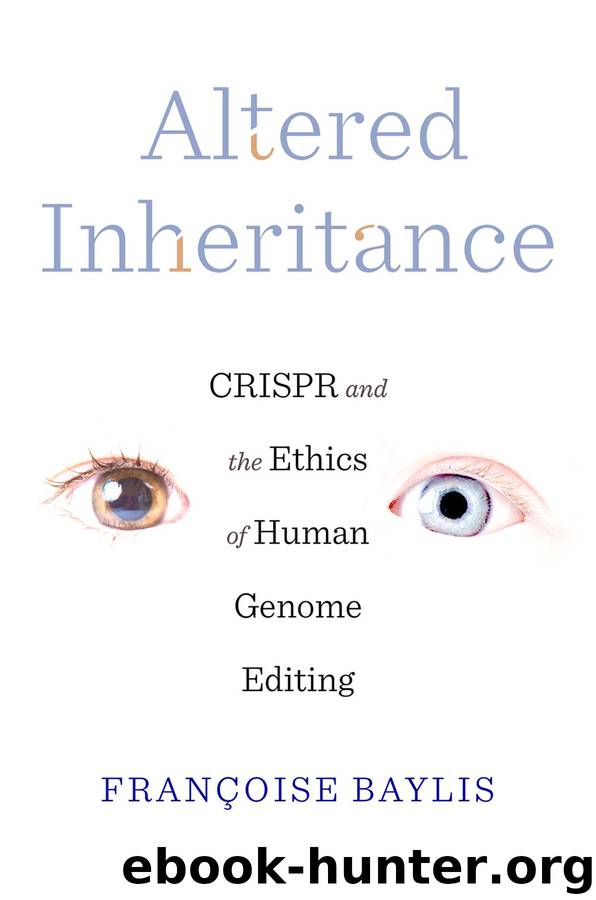Altered Inheritance by Françoise Baylis

Author:Françoise Baylis
Language: eng
Format: epub
Publisher: Harvard University Press
8
Scientists, Science Policy, and Politics
I believe that science collectively, and scientists individually, have a responsibility to serve the common good, and that this responsibility includes contributing to public policy. For obvious reasons, this responsibility falls most heavily on the shoulders of science experts—persons with specialized scientific knowledge and skills. One facet of this responsibility includes making scientific information accessible to members of the public and policymakers. This might involve public speaking and media commentary, committee work that culminates in public reports, or testimony before governmental or quasi-governmental committees. Taken together, these efforts can have a profound impact on public policy.
Earnest discussions about human genetic engineering among scientists and scholars date back to the mid-1960s and early 1970s. Back then, enthusiasts like the American molecular biologists and Nobel laureates Joshua Lederberg and James Watson celebrated the possibility of using genetic technologies to advance scientific and social goals. Lederberg, in particular, underscored the eugenic advantages of human cloning and other forms of genetic engineering, including the creation of human-nonhuman chimeras. Others highlighted the potential dangers of human genetic engineering and questioned the wisdom of “playing God.” American Christian bioethicist Paul Ramsey, in his book Fabricated Man, warned, “Men ought not to play God before they learn to be men, and after they have learned to be men they will not play God.”
These discussions gained a certain momentum in the mid- to late 1990s with the expanding use of IVF for human reproduction and the birth of Dolly, the cloned sheep. And by the spring of 2015, these discussions were in overdrive in response to research published in the Chinese journal Protein & Cell confirming that scientists in China had been doing CRISPR genome editing research using early stage human embryos. Although this research used nonviable human embryos, and the genetically modified embryos were not used to initiate a pregnancy, the research was highly controversial, and all kinds of scientists had all kinds of things to say. From one perspective, this groundbreaking research was a great success because it confirmed that it was possible to modify the genomes of human embryos. From another perspective, it was a spectacular failure because in most cases the genome editing did not work, and when it did work it introduced unexpected and unwanted mutations.
Some scientists criticized the audacity and the scientific capabilities of the Chinese research team. Other scientists focused on what they perceived as an ethical breach. In addition, many scientists commented, either positively or negatively, on the prospect of future genome editing research in viable embryos intended for reproduction. For example, the American molecular biologist and Nobel laureate Craig Mello imagined a possible future in which “altered germ lines would protect humans against cancer, diabetes and other age-related problems.” From a completely different perspective, Edward Lanphier, then-president and chief executive officer of Sangamo Biosciences (later Sangamo Therapeutics) objected: “We are humans, not transgenic rats. We believe there is a fundamental ethical issue in crossing the boundary to modifying the human germ line.”
The publication in Protein
Download
This site does not store any files on its server. We only index and link to content provided by other sites. Please contact the content providers to delete copyright contents if any and email us, we'll remove relevant links or contents immediately.
Periodization Training for Sports by Tudor Bompa(8145)
Why We Sleep: Unlocking the Power of Sleep and Dreams by Matthew Walker(6597)
Paper Towns by Green John(5065)
The Immortal Life of Henrietta Lacks by Rebecca Skloot(4502)
The Sports Rules Book by Human Kinetics(4270)
Dynamic Alignment Through Imagery by Eric Franklin(4099)
ACSM's Complete Guide to Fitness & Health by ACSM(3974)
Kaplan MCAT Organic Chemistry Review: Created for MCAT 2015 (Kaplan Test Prep) by Kaplan(3925)
Introduction to Kinesiology by Shirl J. Hoffman(3710)
Livewired by David Eagleman(3663)
The Death of the Heart by Elizabeth Bowen(3531)
The River of Consciousness by Oliver Sacks(3518)
Alchemy and Alchemists by C. J. S. Thompson(3435)
Bad Pharma by Ben Goldacre(3283)
Descartes' Error by Antonio Damasio(3209)
The Emperor of All Maladies: A Biography of Cancer by Siddhartha Mukherjee(3043)
The Gene: An Intimate History by Siddhartha Mukherjee(3029)
The Fate of Rome: Climate, Disease, and the End of an Empire (The Princeton History of the Ancient World) by Kyle Harper(2988)
Kaplan MCAT Behavioral Sciences Review: Created for MCAT 2015 (Kaplan Test Prep) by Kaplan(2921)
